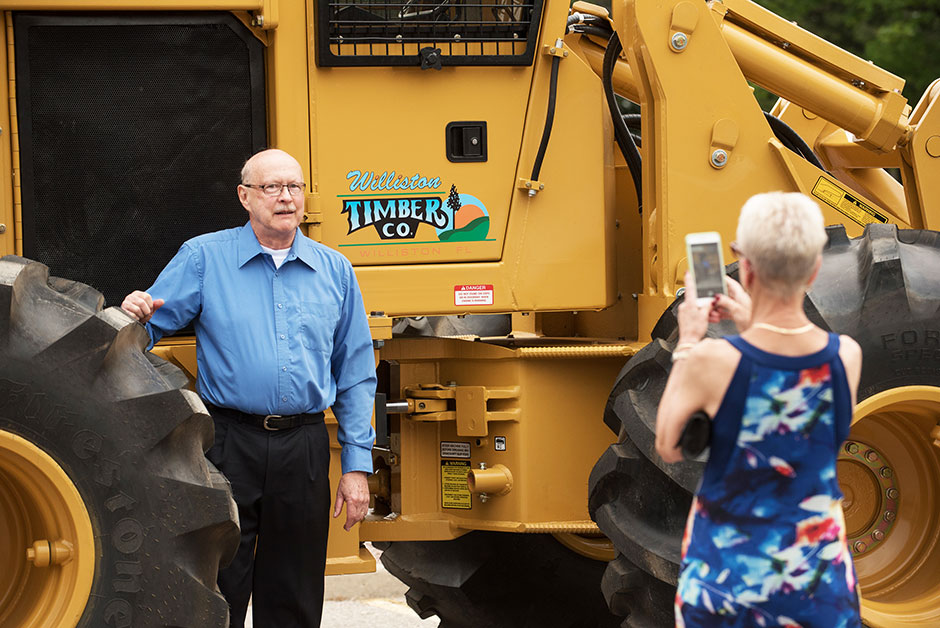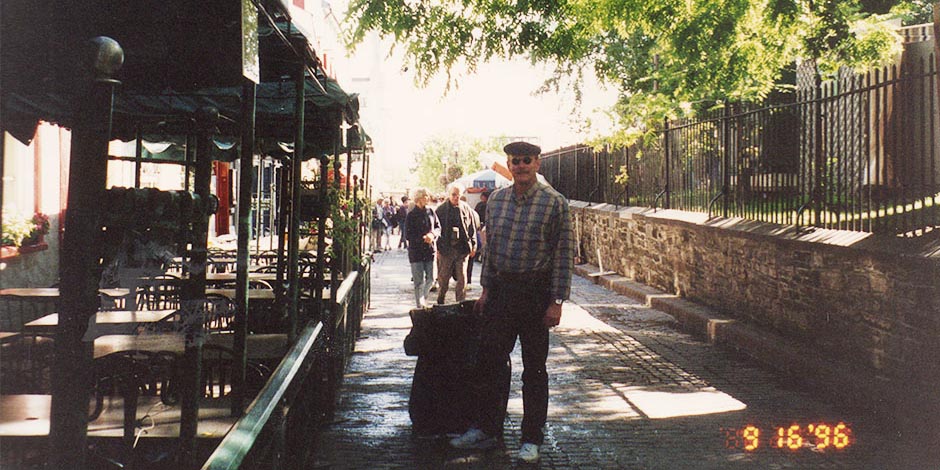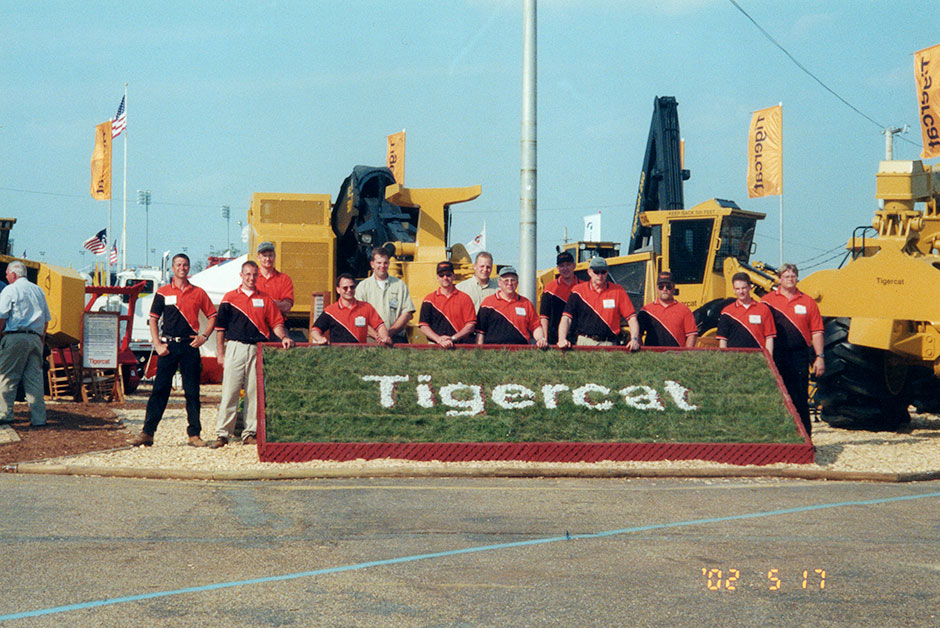4th May 2021
One of a kind. November 9, 1944 – December 16, 2020
– Paul Iarocci
I met Dick Ronald in 1997. He was running the US sales department and he was my boss. Along with me, he was essentially directing a bunch of kids, teaching us how to do our jobs. He was introspective and played his cards tight to the chest, so when he did say something, us kids in the office tended to listen.
Previous to the twelve years Dick committed to Tigercat, he spent 27 years working in the heavy equipment business for Clark, VME and eventually Valmet. He was mainly focused on the forestry side of those businesses, notably product development for the Ranger skidder line. I had asked Dick a few years ago how he came to work at Tigercat. At that time, he responded, “Tony [Iarocci] was looking for somebody, and I think a few of the dealers who Tony was working with and who knew me quite well, were advocating for me to get a job there.”
Dick came up in the seventies when logging in the southern US was wide open. He knew all the players. His relationships with solid independent dealerships like B&G Equipment in Mississippi and Smith & Turner in Georgia were instrumental in Tigercat’s early success, helping the young company to string together a dealer network across the US southeast.

At Tigercat’s 25th anniversary celebration in 2017, Dick poses as his wife Janet snaps a picture of him in front of the very first Tigercat machine ever produced.
“In early 1994 we did not yet have anyone on board in sales administration,” says Tony, Tigercat president from inception until 2017. “I guess I was doing that work myself, so I was happy to hear from a potential candidate with forestry machine experience. I offered him a job soon after he came for an interview even though I wasn’t quite sure if he would be best deployed in a service or sales function. He started in February 1994. It soon became quite evident that he had established close working relationships with some dealers in the US, and also with some big forest products companies in Canada such as Great Lakes Paper in Thunder Bay.”
Bobby Miller, dealer principal and VP at Smith & Turner met Dick in 1986 when the dealership became a VME skidder dealer. According to Bobby, “Dick was our dealer representative. The first thing I remember about Dick was when we went to meetings and shows. When a big crowd would be loudly talking and telling big stories, Dick always seemed to be standing with his arms crossed. Just listening. I know it sounds silly but I wondered what he was doing. It wasn’t until later on I figured out he was learning more by listening to what was being said rather than joining in the conversation.”
District manager, Don Snively spent a lot of time working with Dick over the years, and their relationship extended to Tigercat’s tradeshow efforts – which in the early years were near heroic. Tigercat was a really small company in the nineties that portrayed itself as larger than life in order to compete against a few monstrously large corporations – that unlike Tigercat, presumably had massive trade show budgets and lots of hired help. I recall some of those early tradeshow efforts. It was a DIY effort and everyone worked hard all day. Dick was a really good motivator. I also remember him being the ideas guy. Then he and Don would marshal the troops and get the ideas turned into reality.
He had other sorts of ideas as well. Tigercat owner and CEO Ken MacDonald often made a priority of sending a lot of employees to the big shows. Dick sought to leverage this by dressing everyone in very noticeable orange and black Tigercat themed show shirts for the Atlanta Expo in 1999. The Georgia World Congress Center, the CNN building, the MARTA, all of downtown Atlanta it seemed, was crawling with a Tigercat contingent that resembled hordes of walking, talking orange and black diving flags. It was not subtle but it was very effective.
Don recalls driving a rented but mechanically suspect motorhome with Dick from Ontario to Quebec for DEMO 1996. At one point as Don was hurtling down the 401 at highway speed, he suddenly heard the sound of a skill saw. It was Dick in the back cutting some wooden wedges to beef up the motorhome’s window security.

Dick fitting in with the locals in Quebec City during DEMO 1996.
Then on the way back home, the engine was acting up. Dick removed the interior engine cover and stuck a screwdriver into the carburetor. The engine backfired, sending a plume of black smoke into the cabin and smearing soot on the ceiling. Dick’s deadpan response: “We should get some hot dogs.” Of course you can’t operate power tools in moving vehicles any longer and carburetors are long gone, but Dick was firmly placed in the old school.
Old school or not, Dick came up with some innovative and decidedly new school advertising ideas. Logging industry ads were somewhat conservative 25 years ago, usually consisting of a machine picture and a lot of copy. As Tigercat fought to increase market share with a steadily expanding product line, Dick had the idea to show a full-page image of a light switch with just two words, ‘Just Switch’.
“Dick had a good sense of marketing,” recalls Suzanne Cline, retired Tigercat VP, finance. “I remember being totally blown away arriving at my very first logging show in Richmond, Virginia in May 1996. As you entered the main gates, straight ahead centred in the roadway was the Tigercat site. Flags and banners waved in the breeze and many machines were on display. When I asked Dick how he had scored such a prime spot, he said that no one wanted it as it was beside the chain saws which could be noisy. It gave the sense of it being a ‘Tigercat’ show.”

The Tigercat show crew at Richmond 2002 sporting the infamous orange and black show shirts. They endured for several years. (Dick fourth from right)
He was a diehard Ford man. Dick drove a Bronco and later on, a couple of Mustangs. He usually wore his NASCAR jacket on his daily hour-long commute from St. Thomas to Brantford. He showed up at the same time every day – within minutes of 7:30 am. It didn’t matter the weather, which could be awful along that stretch of highway in winter. As Canadian sales manager Ron Montgomery recalls, “He enjoyed his winter drives to work and arrived every morning on time because he always had the best winter tires.” He made no secret of this – Blizzaks all the way.
Dick had a unique way of looking at the world. “During his commute, he gauged the economy by what the trucking industry did,” says Ron. “He watched the number of trucks on the road and kept a close eye on the inventory while passing the various truck dealers. He was never far off on his predictions.”
Ron and Dick first met in late February, 1995. “I entered what was to be our shared office at 86 Plant Farm Boulevard in Brantford.” This was the sum total of the sales department at that time – one office with two facing desks. “Dick was a man of few words. Tall, confident and always giving you that quiet stare, always listening. When he did speak, you listened.”
Ron continues, “Early on, I learned how well known and respected Dick was in the industry as I crossed paths with people who he had worked with over the years. Dick was a great mentor as he helped me understand the industry and learn about our competition while sharing his massive competitive literature file. He shared stories and experiences about his time at Clark and Valmet. I remember getting excited about selling a few 853E feller bunchers to Spruce Falls in Kapuskasing. Dick later shared with me photos from his days at Clark showing a long convoy of new skidders on floats lining the highway destined for one of the Spruce Falls camps.”
Kevin Selby worked with Dick for seven years in the role of US sales coordinator, and took over Dick’s position upon his retirement. “I’m sure anyone who dealt with Dick will agree with this – the awkward silence in face-to-face or phone conversations was one of his traits.” says Kevin. “He had a wealth of knowledge and was more than willing to teach and share with anyone willing to learn. But I’m not going to lie, it was challenging out of the gate to figure out how to adjust my strategies when communicating with Dick.”
Kevin recollects his first day at the office in 1999. “I’ll never forget this. I arrived a little early and Dick was already in his office. I believe I interrupted his pre-eight am routine. Other than a brief hello, I sat in silence waiting on some discussion and direction. I spent my entire first day sitting there in Dick’s office, much of it in silence, listening to his phone discussions or conversations with colleagues. I remember going home that evening thinking Dick was not a fan of my presence. After some seat time though, I quickly learned he was a true professional and a gentleman. He was my mentor and I am grateful for the seven years working under his leadership. I certainly give him all the credit for my knowledge and growth in the business.”
Dick was a member of the 1968 Ontario Championship Brier Team. Suzanne Cline recalls the words of Jim Waite, a former teammate of Dick’s. “He said that when Dick was younger, he was an exceptional curler who had a goal of winning the Provincial Championship and competing in the Canadian Brier for the St. Thomas Curling Club. The Brier,” explains Suzanne, “is like the Superbowl of curling in Canada. He did this in 1968 with the Don Gilbert team.” Dick promptly ended his competitive curling career after that win, reasoning that he had achieved his goal.
“30 years later at the annual Tigercat Bonspiel, Dick added the Tigercat trophy to his array of accomplishments on the ice,” Suzanne continues. “This fun day was attended by many employees, very few with any curling experience. I suggested to Dick that he should play, and eventually he agreed.” Dick laughed when he found out that he and Suzanne – one of the few experienced players at Tigercat – had ended up on the same team. “I did not have Dick’s level of achievement, but I had won a couple of championships.”
Dick wore jeans on Fridays and he was the handyman around the office in the early days. “He brought in his tools when there was something to add or repair,” recalls Ron. “I remember helping him install a dual water filter in the kitchen. Plastic tubing? Not likely. Dick sourced copper tubing and fittings. He did nothing short of the right way the first time. Over the years, he shared many stories of home building projects.”
He also loved to build up the small dealers. The ownership structure was different in the early days of Tigercat. There were many more small dealers and single store operations, just as there were many more equipment manufacturers. Several people that I spoke to believe that Dick felt that it was a key role of his to nurture and develop these stores to the best of his ability.
“When he came to Tigercat I was just getting my feet wet in sales,” says Bobby Miller. “Dick always seemed to have a soft spot for the smaller dealers like myself. He would help us in situations with getting machines we didn’t think would be possible.” Dick was a big NASCAR fan. Bobby relates that back in the 1990s when Rex Smith (co-founder of Smith & Turner) was still alive, “Rex carried him to Dawsonville to the Bill Elliot racing facilities. He would mention that from time to time for years after that. I saw Dick at the 25th Tigercat anniversary and had the chance to talk to him for a while but after that I hadn’t talked to him until just a few days before he passed away. It was on the Monday after Chase Elliot [Bill Elliot’s son] won the NASCAR championship. My cell phone rang and it was Dick. He said he was watching the race and was thinking back to when he came to Georgia and visited the Bill Elliot shop. He just called to see how we were doing and we talked and reminisced for a while. I will always think of Dick Ronald as a great man. I think he took great pride in being part of the Tigercat legacy.”
“In spite of being a man of few words, he was an effective communicator,” says Tony. “He conducted business effectively and with utmost integrity.” Dick helped to define what Tigercat is today. He will be remembered as a pioneer and an enduring part of Tigercat’s legacy.